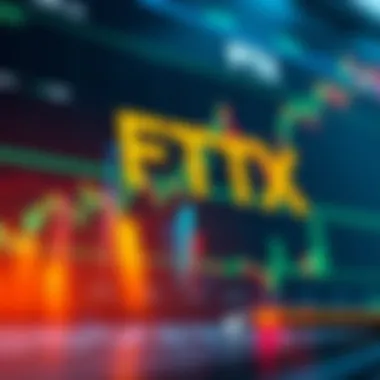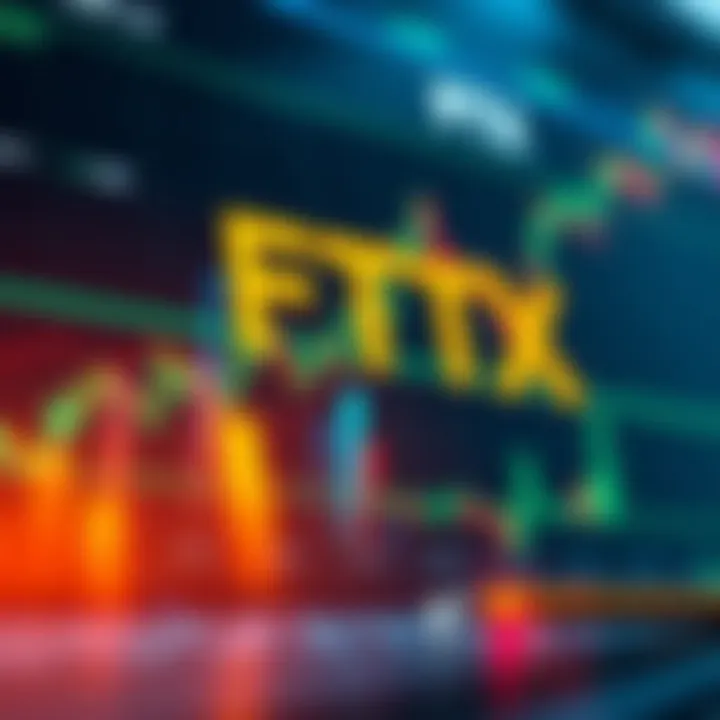Analyzing FTX Exchange Trading Volume: Trends and Impact


Intro
In the fast-paced world of cryptocurrency trading, the dynamics of trading volume serve as a critical indicator of market health and investor sentiment. The FTX exchange, once a prominent player in this field, offers a unique lens through which we can understand these complexities. While many might focus less on the numbers behind trading volume, these figures tell a rich story about market behavior, trends, and the individual strategies of investors. This article seeks to pull back the curtain on FTX's trading volume, examining not just the stats but the underlying factors that drive them.
As we embark on this analytical journey, we'll explore the core concepts that underpin cryptocurrency trading, dissect the prevailing market trends, and speculate on future directions. This narrative will not only enlighten readers on FTX but will also contextualize its significance within the broader cryptocurrency landscape.
Key Concepts in Cryptocurrency
Understanding cryptocurrency requires more than just a passing glance. It involves grasping the technological underpinnings that fuel these digital assets. Here are pivotal concepts for a clearer picture:
Understanding Blockchain Technology
The backbone of most cryptocurrencies is blockchain technology. In simple terms, a blockchain is a decentralized ledger that records all transactions across a network of computers. This transparency is essential in maintaining trust in a digital ecosystem where fraud and deception could easily take root.
- Decentralization: Unlike traditional banking systems, which are controlled by centralized entities, blockchains distribute power among all users. This spreads risk and enhances the integrity of the system.
- Immutability: Once a transaction is recorded on a blockchain, it cannot be altered or deleted, thereby fostering a sense of security for investors.
- Smart Contracts: These are self-executing contracts with the terms of the agreement directly written into code. They eliminate the need for intermediaries, drastically reducing costs and potential disputes.
The Role of Smart Contracts
Smart contracts represent a paradigm shift in how we conduct transactions. In the context of FTX and other exchanges, they allow for:
- Efficiency: By automating processes, smart contracts can expedite transactions that might otherwise take days. This is particularly crucial in a market that values speed and agility.
- Transparency: Investors can see exactly what conditions are laid out in a smart contract, fostering trust and accountability.
- Programmability: Developers can customize smart contracts to create complex trading strategies, which cater specifically to the needs of investors.
By understanding the significance of these concepts, one can appreciate how trading volumes are affected by broader market forces. FTX's strategic utilization of these technologies has implications not just for its operations, but for the cryptocurrency industry as a whole.
Market Trends and Analysis
As we dive deeper into the trading volume of the FTX exchange, it's vital to frame this discussion within the current cryptocurrency landscape.
Current Market Dynamics
The cryptocurrency market is in a state of flux, with prices swinging wildly and investor behavior shifting constantly. Major trends include:
- Increased Institutional Interest: More institutional investors are entering the fray, driving trading volumes to new heights.
- Regulatory Scrutiny: Governments worldwide are beginning to regulate cryptocurrency exchanges more rigorously, which can lead to fluctuations in trading volumes.
- Technological Advancements: Innovations such as layer-2 scaling solutions are making trading faster and cheaper, further influencing trading volumes.
Predictions for Emerging Cryptocurrencies
While Bitcoin and Ethereum often steal the spotlight, many emerging cryptocurrencies are beginning to catch the eye of investors. Predictions suggest:
- Diversification in Portfolios: Investors are likely to look beyond Bitcoin, seeking out smaller, potentially undervalued assets.
- Increased Volatility: Emerging cryptocurrencies often exhibit more volatility than established ones, leading to fluctuating trading volumes as investors react to market news.
The interplay of these market trends not only shapes the trading volume of FTX but also sets the stage for future developments in the cryptocurrency space. As we analyze FTX’s data, it becomes clear that understanding these trends is essential for making informed investment decisions.
"The figures behind trading volume are like the pulse of the market—a way to understand investor sentiment and gauging interest in cryptocurrency."
Through careful examination, this article will continue to unfold the layers of FTX’s trading volume, connecting the dots between volume fluctuations, market dynamics, and ultimately, the strategies that investors employ.
End
In a landscape as intricate as cryptocurrency trading, gaining insights into trading volume is not simply a matter of crunching numbers. Rather, it is an endeavor that requires a multi-faceted understanding of technology, market behavior, and emerging trends. As we move forward in this article, we aim to equip readers with the knowledge to navigate FTX's trading volume and make astute decisions in this ever-evolving environment.
Understanding FTX Exchange
To grasp the intricacies of trading volume, one must first understand the platform it operates on. The FTX Exchange isn't just another trading platform; it represents a significant milestone in the evolution of cryptocurrency trading. As an exchange designed by traders for traders, FTX couples advanced trading capabilities with a user-friendly atmosphere.
Foundations of FTX
FTX was founded in 2019 by Sam Bankman-Fried and Gary Wang. The foundation of FTX rests on several key philosophies: innovation, accessibility, and community engagement. The exchange was established to cater to both professional traders and newcomers. This blend of sophistication and simplicity is one factor that gives FTX its edge. FTX was built on the premise that successful trading requires more than just basic tools; it necessitates an infrastructure robust enough to handle complex trading strategies.
Its structure allows users to trade a wide variety of asset classes beyond just cryptocurrencies. Users can explore derivatives, tokens, and prediction markets, all in one place. This diversification is critical as it appeals to a broader audience, thus driving up trading volume.
Operational Mechanics
Understanding how FTX operates is essential for any investor or analyst. At its core, it employs a liquidity provider model that ensures tight spreads and quick order execution. FTX’s trading engine is designed with performance in mind, handling .5 million orders per second. This is a far cry from the capabilities of older exchanges and significantly enhances the user trading experience.
Additionally, FTX employs a unique fee structure which rewards high-volume traders while imposing lower fees on makers compared to takers. This operational mechanic incentivizes a higher level of trading activity, contributing to its substantial trading volume. Furthermore, the detailed analytics tools provided allow traders to analyze their strategies effectively and refine their approaches, making the platform more appealing.


User Interface and Experience
From a user experience perspective, FTX excels in providing a seamless interface that balances complexity with usability. The dashboard is intuitive, allowing users to navigate between various instruments effortlessly. Whether a trader is looking at futures, options, or spot trading, the interface presents all necessary information in a concise manner without overwhelming the user.
The design aesthetics and layout are modern, promoting ease of access to critical data points. Tools such as real-time charts, order books, and performance metrics are presented clearly.
Moreover, FTX provides users the ability to customize their trading interface. This adaptability means that whether a trader leans toward simplicity or requires a full feature set, they can mold the platform to fit their needs. Such considerations can lead to prolonged use and ultimately higher volume, making user experience a fundamental driving force behind the exchange's trading activity.
"The user experience on FTX is designed with traders' needs at its heart, fostering engagement and continuous trading."
The Concept of Trading Volume
Understanding trading volume is pivotal for grasping the intricacies of cryptocurrency exchanges like FTX. Trading volume represents the total amount of a particular asset that changes hands over a specified period. In the world of cryptocurrencies, where rapid fluctuations redefine market dynamics on a seemingly hourly basis, observing volume can offer valuable insights. By breaking down trading volume, investors and analysts alike can better evaluate market psychology and potential future movements.
Defining Trading Volume
Trading volume can be defined as the number of shares, contracts, or units traded within a specific timeframe. For cryptocurrency exchanges, it's typically measured either daily, weekly, or monthly. The volume figure is not just a number; it reflects the level of interest and activity for a specific asset at any given moment. If a particular cryptocurrency, like Solana, sees a sudden spike in trading volume, it often indicates heightened investor interest, which can be spurred by market news, price changes, or technological advancements.
Factors That Affect Trading Volume:
- Market Sentiment: Positive or negative news can impact traders' decisions, leading to fluctuating volume.
- Technical Events: Announcements of updates, forks, or partnerships can lead to increased trading activity.
- Market Conditions: Bullish or bearish trends often correlate with varying levels of trading volume.
Trading volume, at its core, allows investors to gauge market momentum and potential price movements. In instances where higher volumes accompany price increases, this behavior can signify strength in a trend. Conversely, if prices are rising but volume is decreasing, it might signal a lack of conviction among buyers.
Importance in Market Analysis
In the context of market analysis, trading volume serves as an essential indicator of market health. A high trading volume often corresponds with increased liquidity, making it easier for investors to buy and sell assets without causing dramatic price swings. This characteristic is crucial for traders, as liquidity ensures that positions can be entered and exited efficiently.
Key Benefits of Analyzing Trading Volume:
- Trend Confirmation: When analyzing a price trend, high trading volume adds credibility. Conversely, low volume can lead to uncertainty.
- Identifying Price Reversals: Sudden spikes or drops in volume can signal a potential reversal. For instance, if Bitcoin's price is soaring but volume drops sharply, it may suggest a coming correction.
- Uncovering Institutional Activity: Significant changes in volume might indicate institutional players entering or exiting positions, which can shift market sentiment.
Furthermore, understanding volume trends can position investors to anticipate potential market movements, helping refine trading strategies. Being aware of trading volume alerts investors to scenarios that may not be apparent through price action alone. In this respect, volume is often considered "the backbone" of technical analysis in the cryptocurrency world.
"Trading volume is not just a statistic; it's a reflection of the market's pulse."
In summary, diving deep into the concept of trading volume provides vital tools for navigating the complexities of cryptocurrency trading. Recognizing its importance will enable stakeholders to make better-informed decisions, thereby enhancing their overall trading strategies and investing approaches.
Historical Overview of FTX's Trading Volume
In the world of cryptocurrency, trading volume serves as a vital indicator of market activity and investor interest. Understanding the historical context of FTX's trading volume is essential for investors and analysts alike, as it offers a lens through which market trends can be interpreted. FTX's trading volume has seen various ups and downs, echoing both the broader crypto market and the exchange's own strategic decisions. This section will break down the key phases of FTX's trading volume, exploring initial growth, volume peaks and troughs, and how FTX measures against its competitors.
Initial Growth Phase
In the early days of FTX, a surge in trading volume reflected a rapidly growing user base and an expanding range of products. As FTX launched innovative features such as tokenized stocks and prediction markets, traders flocked to the platform. The novelty factor played a significant role, drawing attention from both retail and institutional investors. In many respects, this period was characterized by FTX's aggressive marketing and strategic partnerships, allowing them to carve out a niche within a crowded market.
Some notable elements during this phase include:
- Market Penetration: FTX swiftly established itself as a recognized name, appealing to traders with competitive fees and unique offerings.
- User Engagement: Active traders were encouraged via promotional campaigns, enhancing trading frequency and, consequently, volume.
- Investor Confidence: This phase fostered a growing narrative around FTX as a ‘disruptor’, enticing investors eager for a fresh perspective on trading in digital assets.
Volume Peaks and Troughs
Moving forward from the initial growth phase, FTX experienced significant fluctuations in its trading volume. Peaks often coincided with major market events, such as price surges in notable cryptocurrencies or broader economic shifts impacting investor behavior. On the other hand, troughs served not only as cautionary signals but also as opportunities for reflection. During these low-volume periods, many traders reevaluated their strategies or sought alternatives.
Key insights from this section include:
- Reaction to Market Events: FTX's trading volume often spiked during volatile events, such as Bitcoin hitting new highs or regulatory news affecting the entire sector.
- Seasonal Trends: There are observable patterns, such as summer slumps or year-end surges, where trading activity diminishes or accelerates respectively.
- User Base Growth: As FTX continued to onboard new users, the increased trading volume often created feedback loops—more traders leading to heightened activity, which in turn attracted even more participants.
"The trading volume acts like a pulse in the FTX ecosystem, reflecting both the excitement of bullish trends and the caution during bear markets."
Comparative Analysis with Competitors
To truly grasp the nuances of FTX's trading volume, it's essential to evaluate it against its key competitors, such as Binance and Coinbase. By laying out a comparative framework, one can discern which factors contribute to FTX's trading volume trends versus other exchanges.
In this analysis, consider the following aspects:


- Market Positioning: FTX has often positioned itself as a user-friendly yet sophisticated platform, aiming to cater to both casual and institutional traders, unlike some competitors that heavily favor retail.
- Features and Offerings: Unique products offered by FTX, including derivatives and leveraged tokens, can alter trading volume dynamics, driving specific trading behaviors not seen on platforms like Binance.
- User Loyalty and Trust: FTX's commitment to transparency and customer service can result in greater long-term user retention, potentially leading to steadier trading volumes compared to competitors facing trust issues.
By diving into these historical aspects of trading volume, it becomes clear that FTX operates in a complex ecosystem, one influenced by a myriad of factors both internally and externally. This historical overview not only sheds light on how FTX has evolved but also lays the groundwork for predicting future trends.
Factors Influencing Trading Volume
Understanding the factors that influence trading volume is crucial for grasping the nuances of how the FTX exchange operates within the broader cryptocurrency market. Trading volume is not merely a number; it reflects the level of participation by traders, investor sentiment, and market dynamics. A deeper comprehension of these factors can illuminate how traders might strategize their investments, thereby forming a cornerstone for successful trading endeavors.
Market Sentiment and News Impact
Market sentiment plays an indispensable role in shaping trading volume on the FTX exchange. Positive or negative news can send ripples through the market, affecting how traders act and react. For instance, favorable announcements regarding partnerships, technological advancements, or regulatory approvals can spark a surge in optimism, leading to increased buying activity.
Conversely, adverse news, such as security breaches or regulatory crackdowns, can drive uncertainty, causing traders to retract and reducing overall volume.
- Key Components of Market Sentiment:
- Public perception of cryptocurrencies.
- Influential figures' opinions or actions.
- Overall economic indicators affecting investor confidence.
The waves of news can either build a buoyant atmosphere for trading or create a tempest, shifting sentiments rapidly from enthusiasm to apprehension.
Technological Developments
Technological advancements also exert a profound influence on trading volume. The FTX exchange has incorporated various cutting-edge technologies that enhance user experience and streamline operations. Features like derivatives trading, margin trading, and automated trading bots can entice traders to engage more actively. For example, the introduction of lightning-fast order execution technology can significantly enhance trading efficiency, attracting more participants to the platform.
Moreover, as blockchain technology continues to evolve, innovations such as decentralized finance (DeFi) applications are shaping the landscape by offering new investment opportunities. This, in turn, can drive trading volume upwards as users flock to adopt new features and instruments offered by the FTX platform.
Regulatory Changes
Regulations wield considerable influence over trading volumes on FTX, as they do across the entire cryptocurrency market. When a new regulation is announced, it can create shockwaves across trading platforms. Understanding these regulations is pivotal for investors; they can either promote stability or introduce obstacles that may restrict trading activities. For instance, if a country implements more stringent compliance measures, some traders may hesitate to operate in fear of future complications.
On the other hand, favorable regulations can invite broader participation, leading to spikes in volume. Being aware of these regulatory landscapes not only helps investors understand potential risks but also prepares them for opportunities created by regulatory shifts.
In summary, a myriad of factors shapes trading volume on the FTX exchange. From swift fluctuations in market sentiment, technological innovations enticing traders, to the overarching regulations that govern operations, all these components create a dynamic environment in which trading strategies can flourish. Understanding these elements allows investors to critically assess potential risks and rewards in their trading journeys.
Volume Analysis Techniques
Understanding volume analysis techniques is crucial for deciphering the intricacies of trading on the FTX exchange. The sheer volume of trades can provide insights not only into market sentiment but also into potential future price movements. This section dives into the underlying importance of these techniques, shedding light on how they can empower investors, developers, and marketers in navigating the ever-changing waters of cryptocurrency trading.
The essence of volume analysis lies in its ability to inform investment strategies through statistical measures and technical assessments. Without it, traders may find themselves navigating blindly, unaware of the signals that trading volume can send.
Statistical Approaches
Statistical approaches lend a scientific touch to volume analysis, providing a structured method for evaluation. These methods often involve calculating average volumes over different time spans to gauge shifts or trends. For instance, one can compute the moving average volume to smooth out the fluctuations and identify longer-term signals.
Moreover, certain metrics, such as the Volume Weighted Average Price (VWAP), serve to weight prices by volume. This can highlight the average price a security has traded throughout the day, offering insights into market pressure.
Key statistical techniques worth mentioning include:
- Standard Deviation: This measure illustrates how much trading volume varies over a specific period, helping traders gauge the volatility of the market.
- Correlation Coefficients: By understanding the correlation between price movements and volume, you can assess how strongly-related these factors are, giving a clearer picture of market dynamics.
With the integration of statistical approaches, traders can decipher deeper insights, transforming raw data into actionable strategies.
Technical Indicators for Volume Evaluation
Technical indicators serve as the bread and butter of volume evaluation, complementing statistical methodologies and enhancing decision-making processes. They also provide visual cues to identify trends and reversals. Popular among these indicators are:
- On-Balance Volume (OBV): This indicator accumulates volume that flows in and out of a security, helping forecast price movements based on volume trends. An increasing OBV often suggests bullish activity, while a declining OBV may indicate bearish sentiments.
- Accumulation/Distribution Line (A/D Line): This metric combines price and volume to determine whether a security is being accumulated or distributed. The trend of the A/D line can indicate the strength of the current trend.
- Chaikin Money Flow (CMF): This indicator considers both the closing price and volume to measure the buying and selling pressure over a specified period. A positive CMF often points to accumulation, whereas a negative indicates distribution.
Incorporating these technical indicators into trading strategies can enhance the ability to predict potential price movements and market behavior. \ Investors who harness these tools are better positioned to make informed decisions instead of relying solely on instinct or conjecture.
Statistical techniques and technical indicators not only enhance volume analysis but also enrich the overall trading narrative, making it vital for any serious investor.
Investor Perspectives on Volume Fluctuations
In the complex landscape of cryptocurrency, understanding trading volume has implications far beyond mere numbers. For investors, volume serves as a vital signpost, offering clues about market health and liquidity. The relationship between volume and liquidity cannot be overstated; as volume often correlates with how easily one can enter or exit a position. High trading volumes typically signify more liquidity, allowing investors to buy and sell assets without significantly affecting their prices. When liquidity dips, it can lead to delays or more significant price swings, making it harder for investors to manage their assets effectively.


- Liquidity: The ease of trading. High volume means more buyers and sellers, leading to smoother transactions.
- Price Stability: A robust trading volume can dampen volatility. With enough activity in the market, the price tends to stay more stable, which is appealing for many investors.
Moreover, looking at volume trends helps investors gauge market sentiment. An uptick in trading volume often precedes sharp price movements, acting as a harbinger of market shifts. If an investor sees a surge in volumes during a bull trend, it might suggest that more participants are stepping into the market, reinforcing the upward momentum. Conversely, a volume decline during price rallies could signal red flags, suggesting that enthusiasm might be waning.
"Volume acts like the pulse of the market. Monitoring it keeps investors attuned to the overall health of their assets."
Investors must also consider that volume is not always indicative of value. A sudden spike in trading activity doesn’t necessarily mean that the asset is blossoming in worth; it could be the result of market speculation or news reactions. Hence, while volume can inform decisions, it should be considered alongside other metrics like fundamental analysis to foster a well-rounded investment strategy.
Volume and Liquidity
The interplay between trading volume and liquidity is central to understanding market dynamics. In real terms, liquidity refers to how easily assets can be converted into cash without causing a significant change in their price. Therefore, a higher trading volume generally leads to stronger liquidity, allowing for quick transactions.
In situations where liquidity is robust, investors can execute their trades closely aligned with the prevailing market price. This aspect becomes particularly crucial during high-stakes trading sessions or market shifts. For instance, a pair like Bitcoin against USDT typically demonstrates significant volume, creating a more liquid environment where large trades can occur without major price disruption.
Considerations about liquidity often include:
- Market Orders vs. Limit Orders: When the volume is high, a trader utilizing market orders can trust that their trades will be filled quickly, minimizing slippage.
- Order Book Depth: High volume indicates a thick order book, suggesting that there are plenty of buyers and sellers ready to take action.
Ultimately, understanding how volume influences liquidity not only supports traders in making informed decisions but also helps in assessing the market's readiness for future movements.
Volume as a Predictor of Price Movements
The ability of trading volume to predict price movements is a phenomenon that many traders and investors rely upon. Historically, spikes in volume have often preceded significant price changes—both upward and downward.
For instance, when an asset experiences a sudden uptick in volume, it can signal either accumulating interest from buyers or panic selling, depending on the context. If this spike occurs in conjunction with positive news, investors may interpret it as a confirmation to buy, sending prices higher. On the flip side, if high volume is seen during a declining price, it may indicate capitulation, resulting in further decreases.
Some key aspects to think about regarding volume as a price predictor include:
- Volume Confirmation: A price increase that coincides with rising volume is often viewed as a validate trend, strengthening the case for potential gains. Conversely, a price rise without corresponding volume could lead investors to question the sustainability of that trend.
- Divergence: Cases in which price movements diverge from volume trends can indicate weakening momentum or upcoming reversals. For instance, if prices continue to rise but volume decreases, it may be a signal for caution.
In summary, while trading volume alone can't predict price movements with absolute certainty, it is a crucial element in a trader's toolbox. When used in conjunction with other analytical techniques, it equips investors with a nuanced understanding of market behavior.
Future Projections for FTX’s Trading Volume
As the cryptocurrency landscape continues to evolve, understanding the future projections for FTX’s trading volume becomes crucial for a variety of stakeholders. Investors, market analysts, and developers can make more informed decisions by grasping these projections. This knowledge not only aids in capital allocation strategies but also plays a role in assessing the overall health of the cryptocurrency market.
Emerging Trends in Cryptocurrency Trading
The cryptocurrency market rarely stands still; it is constantly shaped by emerging trends that influence trading volume. One major trend is the rise of decentralized finance (DeFi), which is shifting the way transactions occur and how trading strategies are formulated. Users are increasingly drawn to decentralized platforms due to their transparency and reduced reliance on intermediaries. This shift could potentially lead to fluctuations in FTX’s trading volume as users migrate between centralized and decentralized exchanges.
Another trend to watch closely is the increasing adoption of non-fungible tokens (NFTs). The popularity of NFTs has opened new pathways for trading and investment opportunities, which often spill over into major exchanges like FTX. If FTX can leverage the NFT wave and provide an efficient platform for trading these digital assets, it may see its trading volume soar.
Additionally, the integration of artificial intelligence and machine learning in trading strategies offers a fascinating lens through which future trading volume can be examined. These technologies promise to enhance market predictions and inform trading decisions in real-time, effectively influencing FTX’s user engagement and activity levels. As institutional investors capitalize on these technologies, FTX stands to benefit significantly in terms of volume.
Potential Market Catalysts
Market catalysts such as regulatory changes, technological advancements, and market events can significantly impact trading volume on exchanges like FTX.
- Regulatory Landscape: The regulatory environment plays a pivotal role. Any changes in legislation that either bolster or hinder cryptocurrency usage will cause ripples throughout the trading volume. Recently, governments have begun to clarify their stances on crypto-assets, which may lead to newfound confidence among investors. A favorable regulatory climate could surely translate into increased trading activity on FTX.
- Technological Upgrades: FTX’s ability to innovate technologically can also serve as a catalyst. If FTX adopts changes to improve transaction speed or security measures, it can create a more attractive trading environment. For instance, implementing cutting-edge security protocols may enhance trust, subsequently driving up trading volume.
- Market Sentiment: Sudden events, like significant market downturns or unexpected bull runs, can cause substantial shifts in trading volume. For instance, if Bitcoin were to hit a new all-time high, trading volumes across exchanges, including FTX, could see a significant uptick as traders rush to capitalize on volatility. Similarly, negative news can spur panic selling, affecting volume in the opposite direction.
Overall, recognizing how these elements interact with FTX’s trading volume sheds light on potential future scenarios. Both public sentiment and macroeconomic events will always play a crucial role in shaping the trading landscape, making it essential to stay informed.
"The future of trading volume is rarely static; it dances to the tune of trends and catalysts that can send ripples through the market."
The End: The Broader Implications of FTX's Trading Volume
As we draw to a close, it's essential to reflect on the wider ramifications of FTX's trading volume within the cryptocurrency ecosystem. Trading volume goes beyond mere numbers displayed on a screen; it serves as a vital indicator of market health, investor sentiment, and liquidity levels. Recognizing these implications is crucial for investors, analysts, and educators alike as they navigate this ever-changing landscape.
Summative Insights
To encapsulate the findings of this exploration:
- Market Indicator: FTX's trading volume significantly influences perception within the cryptocurrency market. High trading volume often indicates robust interest, suggesting that traders are willing to buy or sell, which lends particular credence to price movements. Conversely, low volume may indicate hesitant or inactive investors.
- Investor Behavior: Volume fluctuations offer insights into investor psychology. An uptick in volume may accompany bullish news or market optimism, while a downturn often corresponds with bearish sentiments or regulatory concerns. Investors need to monitor these changes closely to adjust their strategies accordingly.
- Liquidity Considerations: High trading volume equates to better liquidity. For those trading on FTX, this means the ability to execute large orders with minimal slippage, ultimately facilitating smoother transactions. Lower liquidity can hinder trading, increasing costs for investors.
- Competitive Landscape: FTX’s performance relative to other platforms elucidates its standing. Analyzing volume comparisons reveals whether FTX is gaining or losing market share and provides crucial context for potential investors evaluating the exchange. Market movements elsewhere can impact volume on FTX, highlighting the interconnected nature of these ecosystems.
"Understanding trading volume is akin to reading the pulse of the market—it tells you whether things are alive and kicking, or if they’ve quieted to a halt."
Final Thoughts on Market Dynamics
From the perspectives introduced, it becomes clear that the implications of trading volume—particularly at FTX—are manifold and pivotal. The future of trading, especially in a fast-evolving domain like cryptocurrency, will rely heavily on understanding these fluctuations.
The dynamics of regulatory changes, technological advancements, and market sentiment emerge as key players affecting trading volume. Investors must stay abreast of these shifts to make informed decisions. Furthermore, as the market matures, trading volume may serve as a sovereign guide for predicting volatility and potential price movements.







